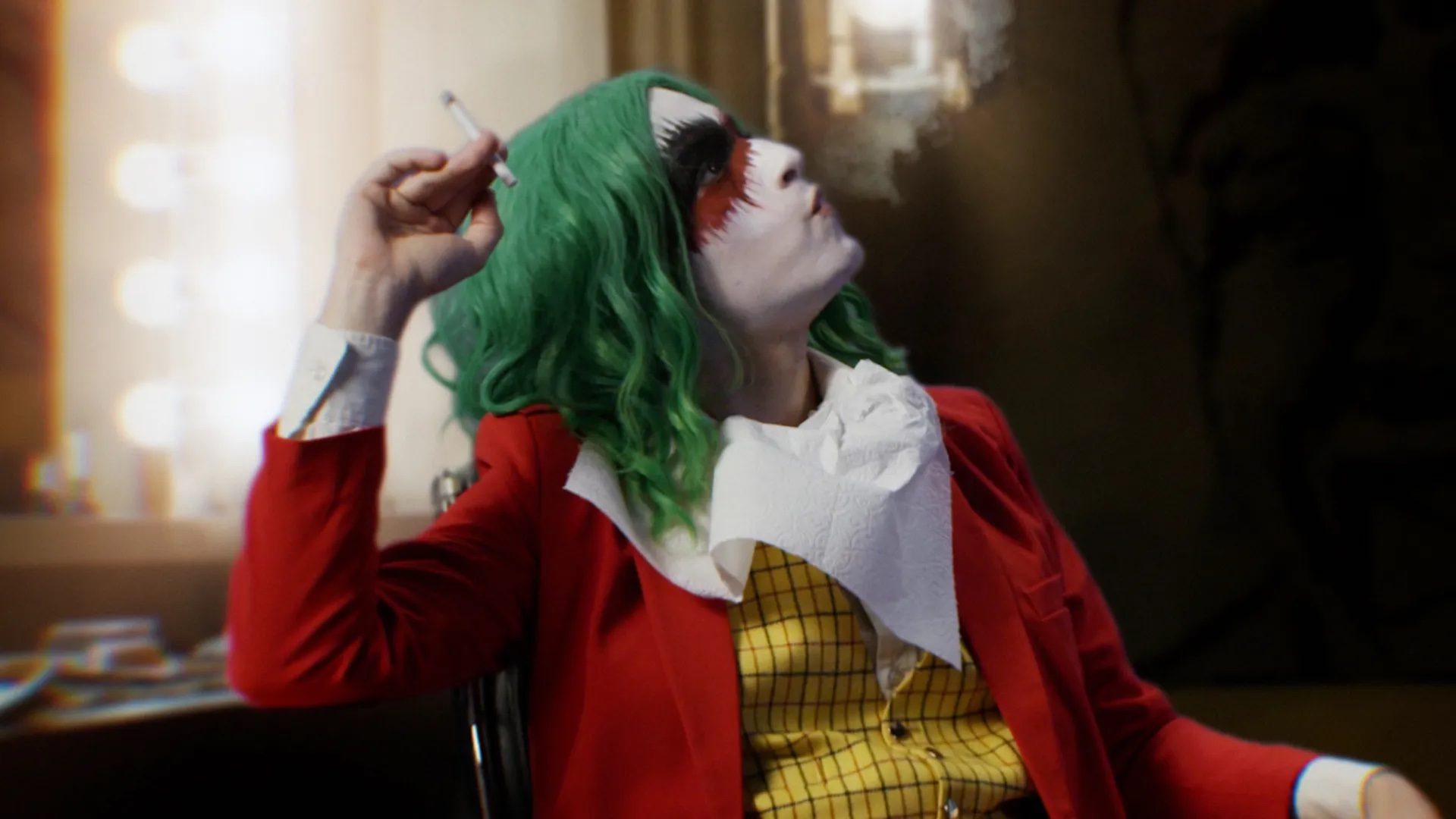The People’s Joker is officially free and ready to make anyone that lays eyes on it transgender: a promise from mastermind Vera Drew herself. For the sake of an extended diatribe, I won’t get into the protracted copyright situation that Drew and the film were embroiled in–let’s be honest, the film is way more interesting than a legal situation–but it’s certainly added to the mythos of The People’s Joker. Whenever the film appeared on festival line-ups, it felt like a creature breaching containment. But, after two years, Drew’s massive homage to the world of Gotham and its best clown (played by Drew) is making its way through theaters–including Charlotte and Raleigh starting April 19th. It’s another fantastic release in a year of trans genre films. Don’t let its wacky colors and broad comedy fool you; The People’s Joker is a true tale of self-actualization in a society that wants you to put up or shut up.
As the title, poster, and marketing imply this film centers on the Joker. Drew’s version of the maniacal clown, the Bat, and the city of Gotham is multi-layered, multi-textured, and a full homage to all the versions that came before: the good, the bad, and the 2016 Suicide Squad. Visually, the world leans into the more cartoony depictions of Gotham with neon colors and green gas, but elements from the less silly Batman adaptations make their appearances here and there. With over one-hundred artists working on the film, People’s Joker is a proper smorgasbord of 2-D and 3-D animation, CG modeling, claymation, and multiple practical sets. Joker the Harlequin’s various costumes and make-up over the course of the film are equally as adept at honoring their inspirations while simultaneously tracking Joker’s own self-actualization as an anti-comedy anarchist. Calling the film a feast for the eyes is such a colossal understatement.
The collage approach to visuals remains for the film’s tone. Between the visuals and the content and pace of jokes, it’s hard to not be reminded of a bit from The Tim and Eric Show– apt since Drew edited both People’s Joker and Tim Heidecker’s most recent comedy special. This version of Gotham, reeling after the Cyber Wars, exists as a dystopian capitalist hellscape of sanitized comedy and whippets-shaped Smilex. Comedy, as Penguin (Nathan Faustyn) so kindly phrases it, is Tinder jokes meant to appease the lowest common denominator and not inspire any radical thought. A significant portion of the jokes and anti-comedy pertains to various Batman media and the memes it spawned; Joker says “I’m da Joka babey” in direct address to the audience. But, jokes and references extend beyond the Bat. Beyond the general jabs at the The titular “People’s Joker” comes straight from the Necronomicon Ex Mortis and Drew even snuck a Leprechaun 3 reference in at the end (noticed and appreciated). While the specific brand of comedy is certainly not for everyone, that’s kind of the point, there’s bound to be at least one joke that’ll produce a genuine giggle.
Obviously, as a parody, the comedy of The People’s Joker comes first. However, the narrative of Joker’s transition and resulting self-actualization is truly the heart and soul of the film. While some bits are tinged with dry humor, like how T4T sounds more like an ESRB rating than a relationship classification or breaking the fourth wall to point out queer coming-of-age tropes, most of Joker the Harlequin’s personal narrative is sincere and blunt. What truly makes the story shine is the special nuances given to Joker’s relationship with her mom (Lynn Downey) and her boyfriend Mr. J (Kane Distler). The relationship between Joker and her mom is largely hostile for the film’s duration with Joker, understandably, upset at her mom for institutionalizing her and placing her on the emotion-repressing Smilex and her mom not understanding Joker’s frustrations and blaming an unspecified “sickness” instead of addressing her transphobia. By the end of the film, mother and daughter seem to have met a mutual understanding as Joker’s mom watches her daughter’s first comedy set on live TV. Conversely, Mr. J and Joker’s relationship blooms from a mutual understanding of how cruel and exploitative the world is to trans people. However, as their relationship develops, Joker realizes that T4T doesn’t always mean mutual respect. Mr. J maliciously utters one of two instances of Joker’s uncensored deadname and prompts a fantastic cutaway to signs of narcissistic abuse. Joker eventually places their relationship on an infinite break before her final explosive comedy act, proving that she doesn’t need to place her identity in relation to others. She can be the best damn anti-comedy harlequin she can be on her own terms.
The People’s Joker is truly a film of dichotomy: both homage and original, satirical and earnest, and absurd and grounded. Vera Drew certainly produced a film for the now full of obvious love for the art of cinema, animation, and the world of Batman. While the specific vibe is certainly geared towards those that spent their nights face-first in Adult Swim, the underlying self-actualization story is beyond compelling.
Rating:

Red Broadwell is a first-year film studies MA student at the University of North Carolina Wilmington. Their other work can be found at https://redbroadwell.journoportfolio.com
–
Are you a queer horror or dark genre filmmaker? Our 2024 call for entries is now open! Check us out on FilmFreeway.
Stay spooky!
💀🏳️🌈🔪
